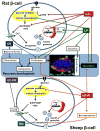Consequences of a compromised intrauterine environment on islet function
- PMID: 20223861
- PMCID: PMC3526069
- DOI: 10.1677/JOE-09-0399
Consequences of a compromised intrauterine environment on islet function
Erratum in
- J Endocrinol. 2010 Sep;206(3):335
Abstract
Low birth weight is an important risk factor for impaired glucose tolerance and diabetes later in life. One hypothesis is that fetal beta-cells inherit a persistent defect as a developmental response to fetal malnutrition, a primary cause of intrauterine growth restriction (IUGR). Our understanding of fetal programing events in the human endocrine pancreas is limited, but several animal models of IUGR extend our knowledge of developmental programing in beta-cells. Pathological outcomes such as beta-cell dysfunction, impaired glucose tolerance, and diabetes are often observed in adult offspring from these animal models, similar to the associations of low birth weight and metabolic diseases in humans. However, the identified mechanisms underlying beta-cell dysfunction across models and species are varied, likely resulting from the different methodologies used to induce experimental IUGR, as well as from intraspecies differences in pancreas development. In this review, we first present the evidence for human beta-cell dysfunction being associated with low birth weight or IUGR. We then evaluate relevant animal models of IUGR, focusing on the strengths of each, in order to define critical periods and types of nutrient deficiencies that can lead to impaired beta-cell function. These findings frame our current knowledge of beta-cell developmental programing and highlight future research directions to clarify the mechanisms of beta-cell dysfunction for human IUGR.
Conflict of interest statement
None of the authors have any conflict of interest that could be perceived as prejudicing the impartiality of the research reported.
Figures

Similar articles
-
The impact of IUGR on pancreatic islet development and β-cell function.J Endocrinol. 2017 Nov;235(2):R63-R76. doi: 10.1530/JOE-17-0076. Epub 2017 Aug 14. J Endocrinol. 2017. PMID: 28808079 Free PMC article. Review.
-
Postnatal pancreatic islet β cell function and insulin sensitivity at different stages of lifetime in rats born with intrauterine growth retardation.PLoS One. 2011;6(10):e25167. doi: 10.1371/journal.pone.0025167. Epub 2011 Oct 12. PLoS One. 2011. PMID: 22022381 Free PMC article.
-
[Fetal programming of type 2 diabetes--intrauterine growth retardation (IUGR) as risk factor?].MMW Fortschr Med. 2010 Oct 14;152 Suppl 3:76-82. MMW Fortschr Med. 2010. PMID: 21595150 Review. German. No abstract available.
-
Prenatal programming of insulin secretion in intrauterine growth restriction.Clin Obstet Gynecol. 2013 Sep;56(3):520-8. doi: 10.1097/GRF.0b013e31829e5b29. Clin Obstet Gynecol. 2013. PMID: 23820120 Free PMC article. Review.
-
Postnatal β2 adrenergic treatment improves insulin sensitivity in lambs with IUGR but not persistent defects in pancreatic islets or skeletal muscle.J Physiol. 2019 Dec;597(24):5835-5858. doi: 10.1113/JP278726. Epub 2019 Nov 29. J Physiol. 2019. PMID: 31665811 Free PMC article.
Cited by
-
Brief neonatal nutritional supplementation has sex-specific effects on glucose tolerance and insulin regulating genes in juvenile lambs.Pediatr Res. 2016 Dec;80(6):861-869. doi: 10.1038/pr.2016.168. Epub 2016 Aug 16. Pediatr Res. 2016. PMID: 27529811
-
Obesity and Metabolic Care of Children of South Asian Ethnicity in Western Society.Children (Basel). 2021 May 25;8(6):447. doi: 10.3390/children8060447. Children (Basel). 2021. PMID: 34070381 Free PMC article. Review.
-
Nutrient sensor signaling pathways and cellular stress in fetal growth restriction.J Mol Endocrinol. 2019 Feb 1;62(2):R155-R165. doi: 10.1530/JME-18-0059. J Mol Endocrinol. 2019. PMID: 30400060 Free PMC article. Review.
-
Fetal adaptations in insulin secretion result from high catecholamines during placental insufficiency.J Physiol. 2017 Aug 1;595(15):5103-5113. doi: 10.1113/JP273324. Epub 2017 May 26. J Physiol. 2017. PMID: 28194805 Free PMC article. Review.
-
Oxidative Stress, Intrauterine Growth Restriction, and Developmental Programming of Type 2 Diabetes.Physiology (Bethesda). 2018 Sep 1;33(5):348-359. doi: 10.1152/physiol.00023.2018. Physiology (Bethesda). 2018. PMID: 30109821 Free PMC article. Review.
References
-
- Adam PA, Teramo K, Raiha N, Gitlin D, Schwartz R. Human fetal insulin metabolism early in gestation. Response to acute elevation of the fetal glucose concentration and placental tranfer of human insulin-I-131. Diabetes. 1969;18:409–416. - PubMed
-
- Aerts L, Van Assche FA. Taurine and taurine-deficiency in the perinatal period. J Perinat Med. 2002;30:281–286. - PubMed
-
- Aldoretta PW, Carver TD, Hay WW., Jr Maturation of glucose-stimulated insulin secretion in fetal sheep. Biol Neonate. 1998;73:375–386. - PubMed
-
- Avril I, Blondeau B, Duchene B, Czernichow P, Breant B. Decreased beta-cell proliferation impairs the adaptation to pregnancy in rats malnourished during perinatal life. J Endocrinol. 2002;174:215–223. - PubMed
-
- Barker DJ, Hales CN, Fall CH, Osmond C, Phipps K, Clark PM. Type 2 (non-insulin-dependent) diabetes mellitus, hypertension and hyperlipidaemia (syndrome X): relation to reduced fetal growth. Diabetologia. 1993;36:62–67. - PubMed
Publication types
MeSH terms
Grants and funding
LinkOut - more resources
Full Text Sources

